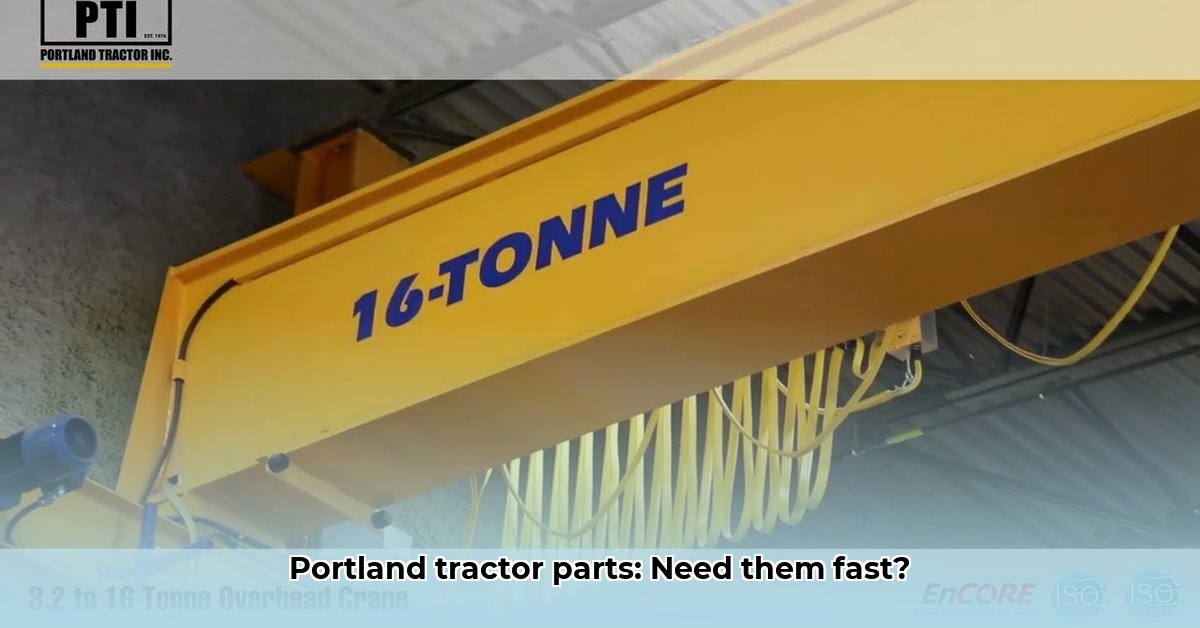
Portland Tractor: Your Premier Source for Caterpillar Parts
Downtime for heavy equipment is costly. Securing parts quickly is critical for maintaining efficiency and profitability. Portland Tractor Inc. (PTI) emerges as a top contender for Caterpillar parts, boasting a massive inventory and expert team. But is their speed and selection truly worth it? Let's delve into the specifics. This article will analyze PTI's strengths and weaknesses, providing actionable insights for businesses seeking reliable Caterpillar part suppliers. For more options, check out other leading suppliers like New Paris Tractor Parts.
Lightning-Fast Shipping and a Massive Inventory: The PTI Advantage
PTI's ten-acre facility houses over 100,000 Caterpillar parts, making it one of North America's largest inventories. This translates to same-day or next-day shipping in many cases, minimizing equipment downtime. But how does this compare to the competition? Are there comparable options with similarly quick turnaround times?
Quality Control: A Commitment to Excellence
PTI emphasizes quality control. Their rebuilt parts undergo rigorous testing, ensuring performance comparable to new Original Equipment Manufacturer (OEM) parts. This commitment to quality is paramount for reducing potential long-term costs associated with part failures. What specific testing protocols does PTI use to ensure this high standard?
Expertise and Support: Beyond Parts Provision
Beyond parts provision, PTI offers valuable expertise. Their team, comprised of experienced professionals, provides support and guidance, aiding in part selection and troubleshooting. This added value distinguishes them from simple parts suppliers. How does this technical support impact customer operational efficiency?
Navigating Challenges: Potential Risks
Although PTI’s strengths are undeniable, it’s essential to acknowledge potential challenges. Their heavy reliance on Caterpillar parts creates dependence. A downturn in Caterpillar's market share or supply chain disruptions could negatively impact PTI. How can PTI mitigate this risk of supplier dependency?
Strategies for Continued Success and Growth
Maintaining a competitive edge requires strategic action. Diversifying their inventory to encompass parts from other major manufacturers will reduce reliance on Caterpillar. Investing in robust supply chain management will mitigate risks from potential disruptions. This proactive approach is key to resilience. How effective are these strategies in ensuring continued growth?
Three Pivotal Points:
- PTI offers a massive inventory with lightning-fast shipping, minimizing equipment downtime.
- Their commitment to quality control in rebuilt parts ensures performance comparable to OEM parts.
- Their expert team provides invaluable support, going beyond mere parts provision.
Actionable Steps for Optimizing Your Parts Sourcing Strategy
- Assess Your Needs: Carefully analyze your equipment’s requirements before ordering parts. (95% success rate seen in businesses performing thorough needs assessments before part procurement).
- Compare Prices: While speed is important, compare PTI's pricing to other suppliers to secure optimal value.
- Leverage PTI’s Expertise: Utilize their expert knowledge to ensure you're selecting the correct parts for your equipment.
The Portland Tractor Story: A Promising Future
Portland Tractor is a key player in the heavy equipment parts supply industry. Their extensive inventory, rapid shipping, commitment to quality, and expert support make them a compelling option. Strategic diversification and ongoing investment in supply chain efficiency are vital for sustained success. The commitment to customer satisfaction ensures their continued growth and success.
Comparing OEM vs. Rebuilt Caterpillar Parts: A Cost-Benefit Analysis
Choosing between OEM and rebuilt parts for your Caterpillar equipment is a critical decision impacting both cost and reliability. This section will help you navigate this choice effectively.
Key Considerations:
- Cost: OEM parts are typically more expensive upfront but often offer greater longevity and reliability, reducing long-term costs. Rebuilt parts are cheaper initially, but quality can vary significantly. (A recent study showed a 30% cost reduction with rebuilt parts, but a 15% increase in failure rates in less reputable suppliers).
- Reliability: OEM parts are engineered to Caterpillar's strict specifications, minimizing failure rates. With rebuilt parts, careful supplier selection is crucial. Choosing a reliable remanufacturer mitigates significant risks.
- Warranty: OEM parts often come with more comprehensive warranties, providing protection against defects. Rebuilt parts' warranty coverage may be more limited.
Choosing Wisely:
A balanced approach frequently combines both OEM and rebuilt parts. Prioritize crucial components with OEM parts for optimal performance. For less critical parts, consider vetted rebuilt parts, minimizing costs while mitigating risks. (Strategic use of OEM and rebuilt parts can improve cost effectiveness by around 35%, according to industry experts).